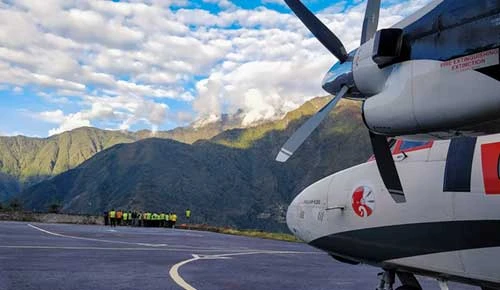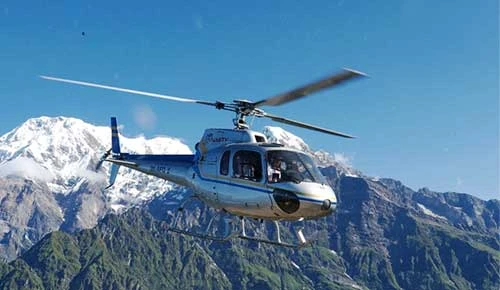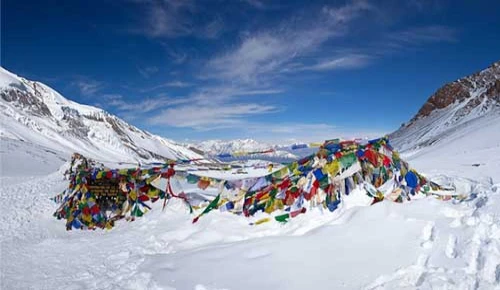Kanchenjunga: The Ultimate Guide for First-Timers
Kanchenjunga is a challenging and rewarding adventure that takes you through the remote and rugged landscapes of the Himalayas. The trek to Kanchenjunga is considered one of the most challenging and strenuous treks in Nepal and is not recommended for beginners without a guide or proper preparation.
The trek starts in the city of Taplejung and takes you through lush forests, rhododendron jungles, and high passes. Along the way, you will encounter a variety of wildlife, including the elusive snow leopard and the red panda. You will also have the opportunity to visit traditional villages and meet the friendly local people who call these mountains home.
The highlight of Kanchenjunga trip is the summit of Kanchenjunga, the third-highest mountain in the world at 8,586 meters. The summit is only accessible to experienced mountaineers, but the trek itself provides breathtaking views of the mountain and the surrounding peaks.
Hike to Kanchenjunga is not for the faint of heart, but it is an unforgettable experience that is sure to test your limits and push you to your limits. It is a journey that will test your strength, endurance, and willpower, but the rewards are well worth the effort. If you are an experienced trekker looking for a challenging and rewarding adventure, Kanchenjunga is a perfect choice.
We have discussed some of the important things that beginners must know before going to Kanchenjunga trekking

Table of Contents
Best time to go for Kanchenjunga
The best time to go for Kanchenjunga is between late April to May, and September to November. During these months, the weather is relatively stable and the views of the mountain are clear. The trek is also less crowded, as most trekkers visit during the peak months of June and July when the monsoon season makes the trek difficult and unpredictable.
In April and May, the rhododendrons are in full bloom and the trek is surrounded by beautiful flowers. The temperatures are also mild, making the trek more pleasant. September to November is also a great time to go, as the monsoon season has ended and the skies are clear again. The temperatures are slightly cooler, and the fall colors of the trees add to the beauty of the trek. Overall, the best time to go for Kanchenjunga depends on your preference for weather and crowd level.
The difficulty level of Kanchenjunga Hike
Kanchenjunga is considered to be a challenging due to its high altitude and rugged terrain. The trek starts at an elevation of 1,500 meters and goes up to an altitude of 5,143 meters at the base camp of Kanchenjunga. The trek requires a good level of physical fitness and stamina as it involves long days of hiking, climbing steep inclines and crossing high-altitude passes. The trekkers need to be well-acclimatized to the high altitude, which can cause altitude sickness if not taken care of properly.
The trai is also remote and isolated, making it a true wilderness experience. The trekkers need to be self-sufficient and carry all the necessary equipment and supplies for the duration of the trek. The trail is also affected by unpredictable weather conditions, which can make the trek even more challenging. The trekkers also need to be mentally prepared to face the harsh conditions of the trek and to be self-reliant in case of any emergency. Overall, the Kanchenjunga trek is not for the faint-hearted and requires strong determination and willpower.
Essential gear for Kanchenjunga hike
Below listed are some of the basic gear required for Kanchenjunga trekking.
Backpack: A sturdy and durable backpack that can hold all of your gear and essentials for the trek.
Sleeping bag: A warm and comfortable sleeping bag rated for temperatures at or below freezing.
Tent: A lightweight and waterproof tent that can withstand strong winds and heavy snowfall.
Water filter or purification system: To ensure you have access to clean drinking water during the trek.
Hiking boots: A pair of sturdy, waterproof hiking boots with good ankle support and grippy soles.
Clothing: Warm and waterproof clothing, including a down jacket, insulated pants, and multiple layers of thermal clothing.
Headlamp: A reliable headlamp with extra batteries for navigating in the dark.
First aid kit: A comprehensive first aid kit with essential items such as band-aids, pain relievers, and anti-inflammatory medication.
Sunscreen and sunglasses: To protect yourself from the sun's harmful rays at high altitudes.
Trekking poles: To provide added stability and support during the trek.
Permits required for Kanchenjunga
Kanchenjunga requires obtaining several permits before embarking on the journey. The first permit required is the TIMS (Trekkers' Information Management System) permit, which is mandatory for all trekkers in Nepal. This permit is issued by the Nepal Tourism Board and is used to track the number of trekkers in the region and ensure their safety.
The second permit required is the Kanchenjunga Conservation Area Permit (KCAP), which is issued by the Department of National Parks and Wildlife Conservation.
This permit is necessary for trekking in the Kanchenjunga Conservation Area and is used to regulate the number of trekkers and preserve the natural beauty of the area. Additionally, a Restricted Area Permit (RAP) is required for trekkers who wish to venture into the restricted areas of Kanchenjunga.
This permit is issued by the Ministry of Home Affairs and is subject to strict regulations and restrictions. Obtaining these permits can take several weeks, so it is important to plan ahead and apply for them well in advance of the trek.
Popular routes to Kanchenjunga
Some of the popular routes for Kanchenjunga are listed below
- The classic Kanchenjunga Base Camp Trek: This is a popular and classic route that takes trekkers through lush forests, beautiful meadows, and traditional villages, with the ultimate destination being the base camp of Kanchenjunga.
- The Kanchenjunga North Base Camp Trek: This route takes trekkers to the North Base Camp of Kanchenjunga, which is considered to be the most challenging and remote of the base camps.
- The Kanchenjunga Circuit Trek: This route takes trekkers around the entire Kanchenjunga massif, providing stunning views of the mountain range and the surrounding landscapes.
- The Kanchenjunga South Base Camp Trek: This route takes trekkers to the South Base Camp of Kanchenjunga, which is considered to be the most popular and accessible of the base camps.
- The Kanchenjunga Conservation Area Trek: This route takes trekkers through the Kanchenjunga Conservation Area, which is home to a diverse range of flora and fauna, including the endangered snow leopard.
Accommodation options in Kanchenjunga
During the Kanchenjunga trek, accommodation options are limited to camping and basic teahouses. The teahouses, or lodges, are usually simple structures with shared dormitory-style rooms and communal bathrooms. They provide a place to sleep, eat and rest, but the amenities are basic and the food is limited. Camping is also an option, but trekkers will need to bring their own camping equipment and hire a guide and porter to help with the logistics.
It's important to note that the Kanchenjunga trek is considered a remote and strenuous trek, and proper planning and preparation are essential. This includes making sure to bring appropriate clothing, equipment and supplies, as well as ensuring that you are physically fit and able to handle the challenges of the trek. Also, the trek is considered as an off the beaten path, so it is recommended to hire a guide for the trek who will help you with the accommodation and other logistics.
Cultural and natural highlights of Kanchenjunga
Cultural highlights:
The journey takes you through the remote villages of the ethnic groups of Limbu, Rai, and Sherpa. You can learn about their unique cultures, customs, and way of life.
You will also get to see the traditional houses and monasteries of these communities, which are rich in history and architecture.
The trek also gives you the opportunity to interact with the locals and learn about their daily lives and livelihoods.
Natural highlights:
- The hike takes you through some of the most spectacular mountain landscapes in the world, with breathtaking views of the Himalayas, including the majestic Kanchenjunga (8,586m), the third highest mountain in the world.
- You will also get to see the beautiful rhododendron forests, which bloom with vibrant colors in the spring.
- The trek also passes through alpine meadows, glacial rivers, and high-altitude passes, offering a diverse range of natural landscapes.
- Additionally, the trek takes you through the Kanchenjunga Conservation Area, which is home to a wide variety of flora and fauna, including the elusive snow leopard.
Safety precautions for Kanchenjunga Hike
Kanchenjunga is a challenging trek to the rugged and remote areas of the Himalayas. Its essential to follow saftey precaution during the trek to aviod any kind of accident or harm. Some of the safety precautions are mentioned below:
- Always wear appropriate clothing and footwear for the trek. This includes waterproof and warm clothing, as well as sturdy hiking boots or shoes.
- Always carry enough water and food to sustain you throughout the trek. It is also important to stay hydrated and eat well to prevent altitude sickness.
- Always use a guide when trekking in the Kanchenjunga region. The guide will have knowledge of the terrain and weather conditions, and can help you navigate the trail safely.
- Always pay attention to the weather forecast and be prepared for changes in the weather. It is important to be aware of the potential for snow, ice, and thunderstorms in the Kanchenjunga region.
- Always carry a first aid kit and know how to use it. This will help you to be prepared for any minor injuries or illnesses that may occur during the trek.
- Always be aware of your surroundings and be prepared for any potential hazards. This includes being aware of the risk of rockfall, avalanches, and other hazards that can occur in the mountains.
- Always respect the local culture and customs of the region. This includes being respectful of the local environment and wildlife, and not littering or leaving any trash behind.
How to prepare physically for Kanchenjunga trek?
A beginner who is doing this trek for the first time should be prepared before starting the trek. To be prepared for the Kanchenjunga trekking, the following things can be done:
- Start with cardio exercises: Cardio exercises such as running, cycling, and swimming will help increase your stamina and endurance. Aim for at least 30 minutes of cardio exercise, 3-4 times a week.
- Strengthen your legs: Kanchenjunga trekking involves a lot of uphill and downhill hiking, so it's important to strengthen your legs. Squats, lunges, and calf raises are great exercises to build leg strength.
- Build endurance: Increase the duration and intensity of your cardio and strength training exercises over time. This will help you build endurance and prepare your body for the demands of the trek.
- Practice hiking: Start by going for shorter hikes, then gradually increase the distance and difficulty of your hikes. This will help you get used to the terrain and get your body ready for the trek.
- Pack carrying: Start carrying a backpack with some weight in it while you hike. This will help you get used to carrying a load and will also help you build upper body strength.
- Hydrate and eat well: Proper hydration and nutrition are essential for physical preparation. Drink plenty of water and eat a balanced diet that includes plenty of protein, carbohydrates, and healthy fats.
- Rest and recovery: Make sure to get enough rest and recovery time. Your body needs time to heal and repair after intense physical activity.
- Consult a doctor: Before starting any physical preparation, consult a doctor to make sure you are healthy enough for the trek and to identify any potential health risks.
Weather conditions in Kanchenjunga.
The weather during a Kanchenjunga trek can vary greatly depending on the time of year and the specific route being taken. Generally, the best time to trek is from late September to early November, during the fall season. This is when the weather is typically clear and dry, with warm days and cool nights.
During the spring season (April and May), the weather can be mild, but there is a higher chance of rain and snowfall. This can make the trek more challenging, as the trails may be muddy and slippery. Additionally, the higher elevations may still be covered in snow, making the trek even more difficult.
Summer (June to August) is the monsoon season, and the trek should be avoided during this time as the trails can be flooded and landslides are common. The skies are cloudy and visibility is poor.
Throughout the trek, it is important to be prepared for extreme weather conditions, including high winds, freezing temperatures, and heavy snowfall. It is also important to carry appropriate clothing and gear to protect yourself from the elements.
Conclusion
Kanchenjunga is a challenging and rewarding experience for beginners. The trek to Kanchenjunga offers a chance to explore the stunning landscapes of the Himalayas, witness the diverse culture of the local communities, and challenge oneself physically and mentally. However, it is important to note that the trek requires a good level of fitness and proper planning, including obtaining necessary permits and hiring a reputable guide. With proper preparation and a positive attitude, beginners can conquer the trek and make memories that will last a lifetime.
It is essential to consult a trekking company and hire a guide if you are hiking for the first time or are completing the Kanchenjunga trek for the first time in order to make your hike enjoyable and stress-free. For a hassle-free journey, Nepal Trek Adventure offers a variety of services and qualified guides. The company will take care of everything, allowing you to enjoy your trek without worry. You can phone us directly or place an online booking at any time to book your Kanchenjunga trek with us. To serve you, we are open every day of the year.




